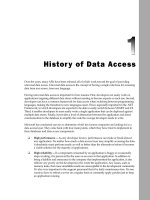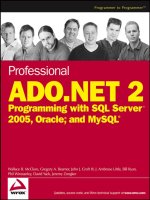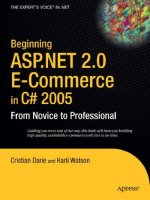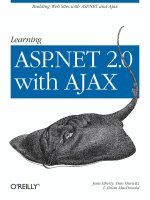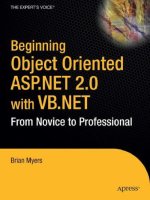Tài liệu Learning ASP.NET 2.0 with AJAX ppt
Bạn đang xem bản rút gọn của tài liệu. Xem và tải ngay bản đầy đủ của tài liệu tại đây (14.14 MB, 522 trang )
Learning ASP.NET 2.0 with AJAX
Other Microsoft .NET resources from O’Reilly
Related titles
ASP.NET Cookbook
™
Essential Silverlight
Learning ASP.NET
Learning JavaScript
Programming ASP.NET
Programming ASP.NET AJAX
Programming C#
.NET Books
Resource Center
dotnet.oreilly.com is a complete catalog of O’Reilly’s books on
.NET and related technologies, including sample chapters and
code examples.
ONDotnet.com provides independent coverage of fundamental,
interoperable, and emerging Microsoft .NET programming and
web services technologies.
Conferences
O’Reilly & Associates bring diverse innovators together to nur-
ture the ideas that spark revolutionary industries. We specialize
in documenting the latest tools and systems, translating the
innovator’s knowledge into useful skills for those in the
trenches. Visit conferences.oreilly.com for our upcoming events.
Safari Bookshelf (safari.oreilly.com) is the premier online refer-
ence library for programmers and IT professionals. Conduct
searches across more than 1,000 books. Subscribers can zero in
on answers to time-critical questions in a matter of seconds.
Read the books on your Bookshelf from cover to cover or sim-
ply flip to the page you need. Try it today for free.
LearningASP.NET2.0
withAJAX
Jesse Liberty, Dan Hurwitz, and Brian MacDonald
Beijing
•
Cambridge
•
Farnham
•
Köln
•
Paris
•
Sebastopol
•
Taipei
•
Tokyo
Learning ASP.NET 2.0 with AJAX
by Jesse Liberty, Dan Hurwitz, and Brian MacDonald
Copyright © 2007 Jesse Liberty and Dan Hurwitz. All rights reserved.
Printed in the United States of America.
Published by O’Reilly Media, Inc., 1005 Gravenstein Highway North, Sebastopol, CA 95472.
O’Reilly books may be purchased for educational, business, or sales promotional use. Online editions
are also available for most titles (safari.oreilly.com). For more information, contact our
corporate/institutional sales department: (800) 998-9938 or
Editor:
John Osborn
Production Editor:
Rachel James
Production Services:
Octal Publishing, Inc.
Cover Designer:
Karen Montgomery
Interior Designer:
David Futato
Illustrator:
Jessamyn Read
Printing History:
September 2007: First Edition.
Nutshell Handbook, the Nutshell Handbook logo, and the O’Reilly logo are registered trademarks of
O’Reilly Media, Inc. Learning ASP.NET 2.0 with AJAX, the image of a pelagic stingray, and related trade
dress are trademarks of O’Reilly Media, Inc.
Microsoft, .NET logo, Visual Basic .NET, Visual Studio .NET, and Windows are registered trademarks
of Microsoft Corporation.
Many of the designations used by manufacturers and sellers to distinguish their products are claimed as
trademarks. Where those designations appear in this book, and O’Reilly Media, Inc. was aware of a
trademark claim, the designations have been printed in caps or initial caps.
While every precaution has been taken in the preparation of this book, the publisher and authors
assume no responsibility for errors or omissions, or for damages resulting from the use of the
information contained herein.
This book uses RepKover
™
, a durable and flexible lay-flat binding.
ISBN-10: 0-596-51397-6
ISBN-13: 978-0-596-51397-9
[M]
This book is dedicated to truth tellers and rational
thinkers; our nation depends on them,
especially now.
Table of Contents
Cheat Sheets
. . . . . . . . . . . . . . . . . . . . . . . . . . . . . . . . . . . . . . . . . . . . . . . . . . . . . . . . . . . .
xiii
Preface
. . . . . . . . . . . . . . . . . . . . . . . . . . . . . . . . . . . . . . . . . . . . . . . . . . . . . . . . . . . . . . . .
xv
1. Getting Started
. . . . . . . . . . . . . . . . . . . . . . . . . . . . . . . . . . . . . . . . . . . . . . . . . . . . .
1
Hello World 2
Creating a New Web Site 2
Creating HelloWorld 6
Making the HelloWorld Web Site Interactive 8
What You Just Did 13
Summary 13
Brain Builder 15
2. Building Web Applications
. . . . . . . . . . . . . . . . . . . . . . . . . . . . . . . . . . . . . . . . . .
17
Mastering Web Site Fundamentals 17
The Page 17
Controls 19
Code-Behind Files 22
Events and Postbacks 22
Synchronous and Asynchronous Postbacks 23
The Page Load event and synchronous postback 26
Adding asynchronous postbacks 29
Controls 31
Organizing the Properties Window 32
Finding properties with IntelliSense 32
Basic Controls 33
viii | Table of Contents
Creating Tables 36
Setting Properties 39
Selection Controls 40
Panels 41
Selection Controls 41
Adding controls with the Item editor 42
Adding items in Source View 43
More Selection Controls 46
Displaying Text 48
Images 51
Links 52
LinkButtons 53
Source Code 54
Summary 59
Brain Builder 61
3. Snappier Web Sites with AJAX
. . . . . . . . . . . . . . . . . . . . . . . . . . . . . . . . . . . . . . .
65
Take a Walk on the Client Side 65
ScriptManager 67
Extending Controls with the Control Toolkit 72
TextBoxWaterMarkExtender 72
PopupControlExtender 76
CollapsiblePanelExtender 82
Source Code Listing 87
Summary 92
Brain Builder 93
4. Saving and Retrieving Data
. . . . . . . . . . . . . . . . . . . . . . . . . . . . . . . . . . . . . . . . .
96
Getting Data from a Database 97
Binding Data Controls 97
Create a Sample Web Page 99
Using a DataSource Control 99
“Pay No Attention to That Man Behind the Curtain” 105
Using the GridView Control 107
Auto-Generated Code 109
Adding Insert, Update, and Delete Statements 112
Table of Contents | ix
Displaying and Updating the Data 116
Take It for a Spin 118
Modifying the Grid Based on Events 119
Selecting Data from the GridView 123
Passing Parameters to the SELECT Query 125
Source Code Listings 128
Summary 136
Brain Builder 137
5. Validation
. . . . . . . . . . . . . . . . . . . . . . . . . . . . . . . . . . . . . . . . . . . . . . . . . . . . . . .
142
Validation Controls 143
The RequiredFieldValidator 144
The Summary Control 152
The Compare Validator 154
Checking the Input Type 156
Comparing to Another Control 157
Range Checking 159
Regular Expressions 160
Custom Validation 162
Summary 164
Brain Builder 166
6. Style Sheets, Master Pages, and Navigation
. . . . . . . . . . . . . . . . . . . . . . . . . .
170
Styles and Style Sheets 170
Cascading Style Sheets 171
Inline Styles 171
Pros and cons 173
Document-Level Styles 173
Pros and cons 174
External Style Sheets 175
Master Pages 180
Creating a Master Page 182
Adding Content Pages 184
Using Nested Master Pages 187
Changing the Master Page at Runtime 191
x | Table of Contents
Navigation 196
Buttons and HyperLinks 196
Menus and Bread Crumbs 200
Site Maps 203
Using Sitemaps 206
TreeView 206
Customizing the look and feel of the TreeView 207
Replacing the TreeView with a menu control 208
Accessing site map nodes programmatically 209
Bread Crumbs 212
Summary 214
Brain Builder 217
7. State and Life Cycle
. . . . . . . . . . . . . . . . . . . . . . . . . . . . . . . . . . . . . . . . . . . . . . .
221
Page Life Cycle 221
State 227
View State 228
Session State 238
Application State 244
Summary 245
Brain Builder 247
8. Errors, Exceptions, and Bugs, Oh My!
. . . . . . . . . . . . . . . . . . . . . . . . . . . . . . . .
250
Creating the Sample Application 250
Tracing 253
Page-Level Tracing 254
Inserting into the Trace Log 256
Debugging 259
The Debug Toolbar 260
Breakpoints 261
Setting a breakpoint 261
Breakpoint window 261
Breakpoint properties 262
Breakpoint icons 265
Stepping Through Code 266
Examining Variables and Objects 268
Debug Windows 268
Table of Contents | xi
Immediate window 268
Locals window 270
Watch window 270
Call Stack window 271
Error Handling 271
Unhandled Errors 272
Application-Wide Error Pages 273
Page-Specific Error Pages 276
Summary 278
Brain Builder 280
9. Security and Personalization
. . . . . . . . . . . . . . . . . . . . . . . . . . . . . . . . . . . . . . .
282
Forms-Based Security 282
Creating Users with the WAT 283
Managing Users Programmatically 289
Creating user accounts 289
Creating a welcome page 290
Creating a login page 293
Roles 295
Restricting Access 298
Testing for login status 300
Testing for role-based authentication membership 300
Personalization 304
Profiles 304
Simple data types 304
Complex data types 310
Anonymous Personalization 314
Migrating anonymous data to an actual user’s record 320
Themes and Skins 321
Create the Test Site 322
Organize Site Themes and Skins 323
Enable Themes and Skins 325
Specify Themes for Your Page 326
Using Named Skins 330
Summary 332
Brain Builder 335
xii | Table of Contents
10. Putting It All Together
. . . . . . . . . . . . . . . . . . . . . . . . . . . . . . . . . . . . . . . . . . . . .
339
Getting Started 339
Adding Styles 340
Using Master Pages 343
Setting Up Roles and Users 346
Logging In 348
Navigation 351
Products Page 354
Adding AJAX 363
Cart Page 365
Purchase Page 368
Confirm Page 375
Custom Error Pages 377
Summary 379
Source Code Listings 379
Cart Page 379
Confirm Page 382
Home Page 384
Login Page 385
Master Page 385
Products Page 388
Purchase Page 392
Web.config 397
A. Installing the Applications
. . . . . . . . . . . . . . . . . . . . . . . . . . . . . . . . . . . . . . . . .
401
B. Copying a Web Site
. . . . . . . . . . . . . . . . . . . . . . . . . . . . . . . . . . . . . . . . . . . . . . .
413
C. Answers to Quizzes and Exercises
. . . . . . . . . . . . . . . . . . . . . . . . . . . . . . . . . . .
425
Index
. . . . . . . . . . . . . . . . . . . . . . . . . . . . . . . . . . . . . . . . . . . . . . . . . . . . . . . . . . . . . . . . .
485
xiii
Cheat Sheets
VB Cheat Sheets
Classes 21
Methods, Event Handlers, Parameters, Arguments 28
Variables and Strings 50
Booleans 52
If-Then Statements 121
CType Method 123
Public and Private Properties 193
The Me Object 196
For Each 211
Catching Errors 212
Helper Methods 232
Arrays and Dictionaries 235
+= Operator 237
Select Case Statement 242
For Loops 253
StringCollection Class 310
Properties 328
SQL Cheat Sheets
Parameters 116
Joins 362
Preface1
ASP.NET 2.0 with AJAX is arguably the fastest, most efficient, most reliable and best
supported way to create interactive web applications available today. Combined with
the development tools available from Microsoft, both free and commercial, it is
incredibly easy to create web sites that look great and perform well. Best of all, most
of the “plumbing” (security, data access, layout, and so on) is taken care of for you
by the .NET Framework.
About This Book
This book will teach you how to build professional quality, interactive, robust data-
driven web applications using Visual Basic 2005. In addition, your applications will
be highly interactive and data driven—must-have features in today’s feature-rich web
world.
ASP.NET is not difficult. All of the concepts are straightforward, and the Visual Stu-
dio and Visual Web Developer environments simplify the process of building power-
ful web applications. The difficulty in ASP.NET is only that it is so complete and
flexible that there are many pieces that must be woven together to build a robust,
scalable, and efficient application. This book cuts to the heart of the matter, show-
ing in clear, easy-to-follow steps, how to understand and build a web site.
Because there are three authors’ names on this book, you might be concerned that
the tone will be uneven. Every possible measure has been taken to avoid this.
Although each chapter was originally written by one author, they were edited by all
three. Every chapter was then extensively edited and rewritten by me, Jesse Liberty,
to give the book a single voice. If that weren’t enough, the chapters were subse-
quently edited by O’Reilly editors as well as independent tech editors, and once
more by the authors. The bottom line is that while three individuals wrote this book,
you should find it reads as if written by just one. This system has worked well with
my previous books. If not, please be sure to let me know by dropping a note in my
support forum ( />xvi
|
Preface
About This Series
O’Reilly Learning books are written and designed for anyone who wants to build
new skills and who prefers a structured approach to studying. Each title in this series
makes use of learning principles that we (with your help) have found to be best at
equipping you with the knowledge you need for joining that new project, for coping
with that unexpected assignment from your manager, or for learning a new language
in a hurry.
To get the most out of any book in the Learning series, we recommend you work
your way through each chapter in sequence. You’ll find that you can get a quick
grasp of a chapter’s content by reading the instructional captions we’ve written for
its examples and figures. You can also use the chapter Summary to preview its key
takeaways and to review what you have learned. Most chapters feature a sample
application, and, if you learn best by reading code, you can turn to the complete
source listing that appears just before the Summary. To bridge any gaps in your
knowledge, check out the Cheat Sheets. Finally, to help you test your mastery of the
material in each chapter, we conclude with a Brain Builder section, which includes a
short quiz and some hands-on exercises.
Learning books work with you as you learn—much as you would expect from a
trusted colleague or instructor—and we strive to make your learning experience
enjoyable. Tell us how we’ve done by sending us praise, brickbats, or suggestions for
improvements to
Learning or Programming?
We have written two ASP.NET books: the one you are currently reading and another
named Programming ASP.NET 2.0. This book, Learning ASP.NET 2.0 with AJAX is
intended for beginning ASP.NET developers, and answers the question: “What is the
quickest way for me to build real web applications with the least handcoding?”
Our other book, Programming ASP.NET is for developers who are saying: “Help me
learn—in depth; show how everything works, and then help me put it to work in
web applications.” The key difference is this book is aimed to make you productive
quickly, while the second book is designed to explore the technology in detail. They
complement each other, but if you are starting out and want to get to work fast, this
is the one for you.
Learning ASP.NET 2.0 with Ajax assumes you know some HTML and have either
some familiarity with Visual Basic 2005 (VB) or C#, or can pick up what you need
along the way. (Or you’re willing to run right out and buy Programming Visual Basic
2005 by Jesse Liberty, although for what you’ll be doing here, you won’t really need
it). To help with this, we have included VB Cheat Sheets throughout the book to
explain and clarify some of the VB topics for newbies.
Preface
|
xvii
VB Versus C#
A quick note on Visual Basic versus C#: Some people choose a .NET book based on
what language the examples are given in. That’s a natural reaction, but it’s really not
necessary, and here’s why: There is very little actual VB or C# code in any given
ASP.NET program, and what there is, you can easily translate from one to the other
“on inspection.” Besides, the two languages are strikingly similar. If you know one,
it’s quite simple to learn the other. In fact, there are software tools that can convert
one language to the other with amazing accuracy. Finally, ASP.NET programmers
benefit terrifically by being “bilingual”—that is, having the ability to read VB and
write C# (or vice versa).
How This Book Is Organized
Chapter 1, Getting Started, walks you through creating your first web site,
HelloWorld.
Chapter 2, Building Web Applications, goes over the fundamentals of web sites and
covers the basic controls available to you in ASP.NET.
Chapter 3, Snappier Web Sites with AJAX, shows you how to integrate this powerful
client-side technology into your pages.
Chapter 4, Saving and Retrieving Data, shows you how to make your site interact
with data stored in a database. You have controls to retrieve data, allow your users to
interact with that data, and then save it back to the database.
Chapter 5 looks at Validation. ASP.NET provides extensive support for data valida-
tion, including ensuring that a choice has been made, checking that values are within
a range, and matching regular expressions.
Chapter 6, Style Sheets, Master Pages, and Navigation, shows you how to make web
sites that are professional quality, good looking, consistent, and easy to navigate.
Chapter 7 examines State and Life Cycle in ASP.NET. Understanding how, and in
what order, a page and its controls are created on the server and rendered to the
browser is crucial for building successful interactive web sites. State is the current
value of everything associated with the page. This is mostly handled automatically,
but this chapter shows you how useful it can be to the developer.
Poop happens. Chapter 8, Errors, Exceptions, and Bugs, Oh My!, shows you how to
deal with unexpected problems, and also how to debug your application.
Chapter 9, Security and Personalization, shows how you can protect your web site
from malicious users. A related topic is personalization, which allows your end users
to customize the look and feel of the web site according to their personal prefer-
ences. You will see how to use themes and skins to accomplish this.
xviii
|
Preface
Chapter 10, Putting It All Together, is a single, large example that integrates every-
thing you have learned throughout the book.
Appendix A, Installing the Applications, tells you what hardware and software is
required to run the examples in this book, and helps you set up your environment.
Appendix B, Copying a Web Site, describes the process of copying a web site to a new
web site. This is a technique used often throughout this book when building up
examples.
Appendix C, Answers to Quizzes and Exercises, presents detailed solutions to all the
quiz questions and practice exercises found at the end of each chapter.
Conventions Used in This Book
The following font conventions are used in this book:
Italic
Used for pathnames, filenames, program names, Internet addresses, such as
domain names and URLs, and new terms where they are defined.
Constant Width
Used for command lines and options that should be typed verbatim, and names
and keywords in program examples. Also used for parameters, attributes,
expressions, statements, and values.
Constant Width Italic
Used for replaceable items, such as variables or optional elements, within syntax
lines or code.
Constant Width Bold
Used for emphasis within program code examples.
Pay special attention to notes set apart from the text with the following icons:
This is a tip. It contains useful supplementary information about the
topic at hand.
This is a warning. It helps you solve and avoid annoying problems.
Support: A Note from Jesse Liberty
I provide ongoing support for my books through my web site. You can obtain the
source code for all of the examples in Learning ASP.NET at:
Preface
|
xix
There, you’ll also find access to a book support discussion group that has a section
set aside for questions about Learning ASP.NET. Before you post a question, how-
ever, please check my web site to see if there is a Frequently Asked Questions (FAQ)
list or an errata file. If you check these files and still have a question, then please go
ahead and post it to the discussion center. The most effective way to get help is to
ask a precise question or to create a small program that illustrates your area of con-
cern or confusion, and be sure to mention which edition of the book you have (this is
the first edition).
Using Code Examples
This book is here to help you get your job done. In general, you may use the code in
this book in your programs and documentation. You do not need to contact us for
permission unless you’re reproducing a significant portion of the code. For example,
writing a program that uses several chunks of code from this book does not require
permission. Selling or distributing a CD-ROM of examples from O’Reilly books does
require permission. Answering a question by citing this book and quoting example
code does not require permission. Incorporating a significant amount of example
code from this book into your product’s documentation does require permission.
We appreciate, but do not require, attribution. An attribution usually includes the
title, author, publisher, and ISBN. For example: “Learning ASP.NET 2.0 with AJAX,
by Jesse Liberty, Dan Hurwitz, and Brian MacDonald. Copyright 2007 Jesse Liberty
and Dan Hurwitz, 978-0-596-51397-9.”
If you feel your use of code examples falls outside fair use or the permission given
above, feel free to contact us at
We’d Like to Hear from You
Please address comments and questions concerning this book to the publisher:
O’Reilly Media, Inc.
1005 Gravenstein Highway North
Sebastopol, CA 95472
800-998-9938 (in the United States or Canada)
707-829-0515 (international or local)
707-829-0104 (fax)
We have a web page for this book, where we list errata, examples, and any addi-
tional information. You can access this page at:
/>To comment or ask technical questions about this book, send email to:
xx
|
Preface
For more information about our books, conferences, Resource Centers, and the
O’Reilly Network, see the web site:
Visit the O’Reilly .NET DevCenter:
/>Safari® Books Online
When you see a Safari® Books Online icon on the cover of your
favorite technology book, that means the book is available online
through the O’Reilly Network Safari Bookshelf.
Safari offers a solution that’s better than e-books. It’s a virtual library that lets you
easily search thousands of top tech books, cut and paste code samples, download
chapters, and find quick answers when you need the most accurate, current informa-
tion. Try it free at .
Acknowledgments
From Jesse Liberty
I am particularly grateful to John Osborn who has shepherded all my work through
O’Reilly as well as the editors and production folk at O’Reilly who (as always) made
this book so much more than what we originally created.
From Dan Hurwitz
In addition to the people mentioned by Jesse, as always I especially want to thank my
wife for being so supportive of this project. It sounds trite and repetitious, but it
would not be possible without her help.
From Brian MacDonald
My thanks, first and foremost, go to Jesse and Dan for inviting me to be a part of this
project. My deepest appreciation goes to John Osborn for getting me involved with
O’Reilly in the first place, many years ago now. Thanks as well to Dan Maharry for
his technical feedback, especially on the exercises. Finally, thanks to my wife, Carole,
who provided technical as well as emotional support, and to my son, Alex. You both
put up with a lot of my absences while I worked on this book, and I thank you for it.
1
Chapter 1
CHAPTER 1
Getting Started1
Learning ASP.NET 2.0 with Ajax will teach you everything you need to know to
build professional quality web applications using Microsoft’s latest technology,
including ASP.NET 2.0 and AJAX. ASP.NET is Microsoft’s tool for creating
dynamic, interactive web pages and applications. Using plain vanilla HTML, you can
make a web page that has some great content, but it’s static. The content doesn’t
change, no matter what the user does. You can even use Cascading Style Sheets
(CSS) to make it the most visually impressive thing on the Web, but if what you
really need is for users to be able to leave comments, or browse your inventory, or
buy things from you, then HTML alone won’t get it done.
That’s where ASP.NET 2.0 comes in. Within these chapters, you’ll find out how to
do all the great tricks that you see on the most popular commercial web sites. Order
forms? We’ve got that. Interact with a database? You’ll do that too. Dynamic naviga-
tion tools? It’s in here. Personalized appearance that the user can customize? No
problem.
The best part is, you’ll do it all with minimal coding. You can make ASP.NET pages
in your favorite text editor if you want, but that’s a bit like using a hammer and
chisel to write the Great American Novel. If you use Visual Studio 2005, or its free
counterpart, Visual Web Developer, adding features to your page is as simple as
dragging and dropping. The tools generate most of the code for you. If you’re an old-
school type who cringes at the idea of letting someone else write your code, it’s all
still there, and you can tweak it to your heart’s content. Consider this, though:
would you rather spend your time writing the code for another radio button list, or
figuring out what to do with the data that you gather using it? In short, the tools do
the tedious chores for you, so you can get to the good stuff.
On top of all this, you can enhance your ASP.NET 2.0 site with AJAX, which is more
than just résumé enhancement; it’s a genuine improvement in the user experience.
When a user is browsing your product catalog, and she clicks on one of your thumb-
nail images to view the product’s details in another panel, she simply expects it to
work instantly. She doesn’t want to wait while the page contacts your server, reloads,
2
|
Chapter 1: Getting Started
and then redraws itself with the new information. With AJAX, she won’t see any of
that. The update is seamless, and the user never has to slow down. You’ll see AJAX
tools used throughout this book. In fact, Chapter 3 is dedicated solely to just that
topic, so you can use AJAX with everything else we’ll show you.
One of the wonderful characteristics of the tools (Visual Web Developer or Visual
Studio) and the technology you’ll be using (ASP.NET and ASP.NET AJAX) is that
you’ll be able to create your applications with drag and drop programming and just a
little bit of hand coding to handle “events” (such as what happens when the user
clicks a button). Not toy applications—meaningful business applications.
By the time you’ve finished this book, you’ll be able to do all of that and more, and
you’ll learn about it by doing it yourself—hands-on. If you don’t have Visual Studio
or Visual Web Developer installed yet, turn to Appendix A now for detailed instruc-
tions on how to install and set it up. Once you’ve done that, it’s time to dive right in
and create your first application, “Hello World.”
Hello World
One of the most difficult problems in beginning any programming technology is the
“bootstrap” problem. That is, writing your first program requires using techniques
that you haven’t learned yet, but learning those techniques in a vacuum is not only
boring, but to some degree pointless because there’s no context, and thus no way to
integrate that which you learned.
The traditional solution to this dilemma is to create the canonical “Hello World”
program. Our Hello World web site will allow us to demonstrate many useful
aspects of ASP.NET without overwhelming you with detail. We promise we will
explain every aspect of this web site in detail, as we go along.
According to Wikipedia ( the
tradition of a Hello World program dates back to a 1974 Bell Labora-
tories memorandum by Brian Kernighan.
This introductory web site will have only a Button and a Label control. Initially the
Label will display the text “Label.” When the user clicks the Button, the Label text
becomes “Hello World.” Very cool, eh? You can see the finished product in
Figure 1-1, after the user clicked the button.
Creating a New Web Site
To get started, open the Integrated Development Environment (IDE), which for
these purposes is either Visual Web Developer or Visual Studio. (Throughout this
book, we will use the acronym IDE for both, specifically using VS or VWD only
where they are different.)
Creating a New Web Site
|
3
To create a new web site, click on the menu item File ➝ New Web Site…, or alterna-
tively, use the Create: Web Site… link on the Start Page. Either way, you should see
the New Web Site dialog, like the one shown in Figure 1-2.
In this book, we will be using Visual Basic as our default language,
although it is the profound belief of the authors that Visual Basic and
C# are really a single language, just with slightly different syntax.
We will be showing many of our screen shots from Visual Web Devel-
oper, because it is freely available from Microsoft, however, anything
that can be done in Visual Web developer can also be done in Visual
Studio.
Take another look at Figure 1-2, and we’ll examine it in some detail. In the upper
part of the window, you are offered various Visual Studio templates (though yours
may vary). Select the ASP.NET Web Site template, because that is the kind of site
that you are going to create (shown circled in this figure).
In the Location drop-down box at the bottom of the dialog box, select File System
(the other options are HTTP or FTP; we’ll explain this selection later in the next
section).
The Location drop-down in Figure 1-2 covers up another drop-down in which we
have set the language to Visual Basic (rather than to Visual C# or Visual J#). Finally,
you need to specify where on your disk you would like this web site to be placed—in
this case, in the LearnASP directory on the C drive.
Figure 1-1. This is what the HelloWorld web site will look like after the user clicks the Button.
4
|
Chapter 1: Getting Started
The name of the new web site will be HelloWorld (with no space character). The site
will be fully contained in a subdirectory named HelloWorld within the directory
LearningASP.
Click OK; the IDE will create the directory for you, put the needed default files for
your site within it, and then open the IDE.
You can confirm that the files are in the right place by navigating to the specified
directory using Windows Explorer, as shown in Figure 1-3. When you work on your
site, however, you’ll most likely access these files through the Solution Explorer win-
dow located on the right-hand side of the IDE window.
The Location field in Figure 1-2 is really comprised of two parts: a drop-down with
three possible values, and a text box for the folder name and path. The drop-down
choices are File System, HTTP, and FTP.
File System is the default choice for new web sites and the only choice we’ll be using
in this book. It creates a new web site folder somewhere on the physical file system,
either on your local machine or your network. One important feature of ASP.NET is
Figure 1-2. To create a new web site, open the IDE, and click on Menu ➝ New Web Site to open
the New Web Site dialog box. The Templates and My Templates panels show you the types of sites
supported by your version of Visual Studio.
Selected template
Location drop-down Web site folder and name
